The use of boric acid for plants: tomatoes, cucumbers, peppers and other crops
Boric acid is used for plants in the garden and vegetable garden as an algaecide, fungicide, herbicide and insecticide. This means that boron causes damage to many types of pests, weeds, fungi, and mold. In addition, the compound promotes the formation of ovaries in tomatoes, cucumbers and other plants.
The effect of boric acid on plants
Boric acid is a unique fertilizer that solves many problems in caring for cultivated plants. At low concentrations, the acid acts as a nutritional component.
Properties
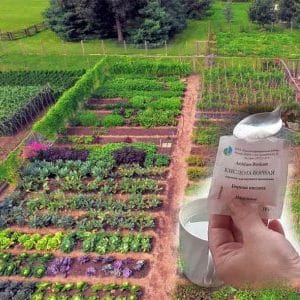
Boric acid and sodium borate salts are pesticides that can be found in many foods. These compounds contain boron, oxygen and hydrogen. Boric acid crystals are white, odorless and almost tasteless. The substance looks like fine table salt or baby powder.
Borates are a general term for boron-containing compounds such as borax and boric acid. They are mined from dry salt lakes in deserts and arid regions (Death Valley, California, Turkey, China) and other regions that are rich in similar deposits (Andes Mountains in South America).
Effect
Boron is a microelement essential for plant growth.. Without enough boric acid in the soil, plants may appear healthy but will not bloom or bear fruit. Water, organic composition and soil structure are factors that affect the amount of boron in the soil.
Boron controls the transport of sugars in plants. The concentration of boron in the soil is negligible, but among micronutrients, boron deficiency in plants is the most common. Overwatering reduces boron concentrations in the soil by leaching nutrients from the roots.
Important! High concentrations of boron in soil are toxic to plants.
What does boron deficiency and excess lead to?
The first signs of boron deficiency in plants appear in growth and development: leaves turn yellow, growing shoots wither. The fruits, which is especially noticeable, for example, in strawberries, become lumpy and deformed. Productivity is falling.
When the level of boric acid in the soil is too high, the lower leaves burn, marginal necrosis occurs, and the leaves are pulled out and fall off.
Application for vegetables
Toxic in large doses, boric acid can kill insects, fungi and weeds, making it an ideal tool for gardeners.
Pepper
Boron acid is used to feed peppers by watering them at the root, but only when signs of microelement deficiency become noticeable. Boron strengthens the roots of peppers: they grow faster, develop, and provide strength for the growth of young shoots. Boron is used as an antiseptic: it prevents root rotting at high humidity.
Attention! To avoid boron deficiency, begin seed treatment before planting. The seeds are soaked in a boric acid solution for a day and then planted in the ground.
Treatment with boric acid and potassium permanganate protects pepper from damage late blight. As a preventive measure, in mid-June they are sprayed with potassium permanganate, after 7 days the plants are treated with boron solution (1 teaspoon per bucket of water), and after a week they are sprayed with iodine solution.Such measures will protect peppers and other plants from late blight until the end of summer. Preferably, pepper is treated by spraying with boric acid several times during fruit ripening.
Tomatoes
Experienced gardeners know that tomatoes do not need more fertilizing, if they were planted correctly. However, even if you apply fertilizer when planting seedlings, it is impossible to control the boron content in the soil.
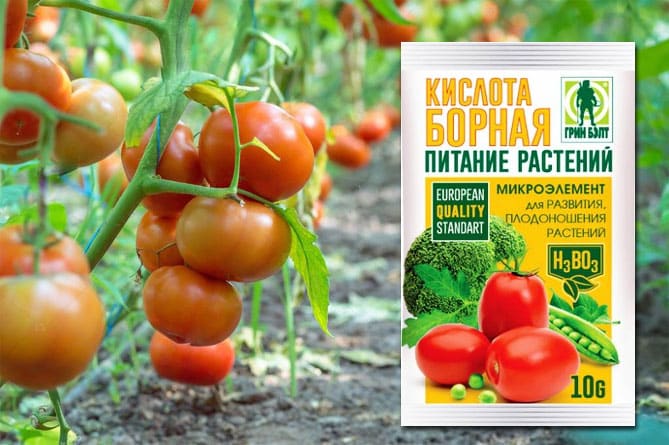
If tomatoes planted in open ground lack boron:
- the leaves will lose their normal color, although the top of the plant will still be green;
- dark veins will appear on the leaves, the leaves will gradually curl;
- the tomato stem will become brittle;
- spots will appear on the fruit.
cucumbers
Spraying cucumbers with boric acid is not only increases the ovaries, but it also helps to avoid color loss. To prepare the solution, mix 10 g of boric acid and 2 g of potassium permanganate in a bucket of hot water. Treatment is carried out at the beginning of flowering. If you add 40 drops of iodine, you will get an excellent remedy for the prevention of bacterial diseases.
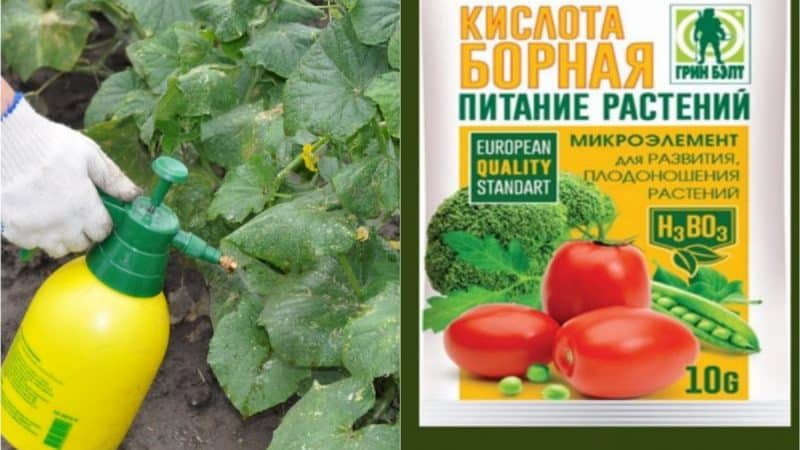
Other advantages of using boron solution for cucumbers:
- strengthens the plant;
- increases the amount of sugar;
- protects against parasites.
Application in the garden
Boric acid is recommended as a means of killing ants and silverfish at home and as a herbicide in the garden. Boron is necessary for the growth of fruit trees and shrubs, but only in small quantities. Excessive amounts of fertilizer are toxic to plants and will remain in the soil for a long time.
A solution of boric acid is sprayed twice during the growing season. The last processing is performed to increase the sugar in the fruits, this will improve their taste.The solution is prepared in the proportion of 10 g of substance per 10 liters of water. Depending on the culture, the concentration may vary. It is advisable to perform the procedure in the evening to avoid burns on the leaves.
For preventive purposes, spraying the crown is recommended at the beginning of flowering, then repeat the procedure a week later. Treatment solution prepared at the rate of 20 g of powder per 10 liters of water.
Attention! Using small amounts of boric acid in the garden will do good apple, cherry, pear. But overapplication will reduce soil quality and may hinder plant growth for several years.
How to prepare the solution correctly
To make the solution beneficial for plants, adhere to the established proportions and follow safety rules.
Proportions
Mix boric acid powder, sugar and water: 2 tbsp. l. boric acid and 2 cups of sugar for every glass of water. Sugar will attract pests, including ants and cockroaches, and boric acid will kill them.
Advice! Use hot water to dissolve the acid quickly.
Recipes
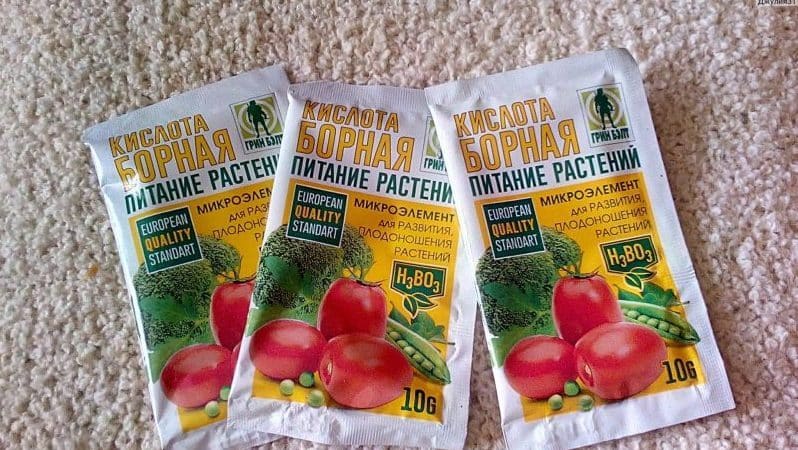
Boron has disinfectant properties. In the fight against late blight, gardeners use an antiseptic solution to treat bushes: dissolve 10 g of the drug in 10 liters of hot water and add 20 drops of iodine. The solution is sprayed onto the stems and leaves.
Folk remedies will saturate plants with potassium and help get rid of bacterial and putrefactive diseases, such as black leg and root rot. Take 2 g of boric acid, 1 tbsp. l. urea, 2 g of potassium permanganate, half a glass of ash, dilute in 10 liters of water and water the plants. Potassium permanganate will help sterilize the soil from harmful flora; ash deoxidizes the soil well.
How to spray plants correctly
Boron is used in gardening to accelerate the growth of vegetable crops and increase germination. It is recommended to place the seeds in a gauze bag before planting and soak them in a boric acid solution for 2 days at the rate of 0.2 g per 1 liter of hot water.
Step-by-step instruction
The spraying time depends on the characteristics of the pathogens, the nature of the disease, the phase of plant development and weather conditions. For 1 m2 use 1 liter of solution. Procedure:
- Before spraying plants with boric acid solution, make sure it is non-toxic.
- Spray the plants at a distance of 20 cm, smoothly moving the spray bottle.
- During the spraying process, ensure the homogeneity of the solution, stirring it periodically
- Make sure that the solution evenly covers the entire area - trunk, foliage and fruits.
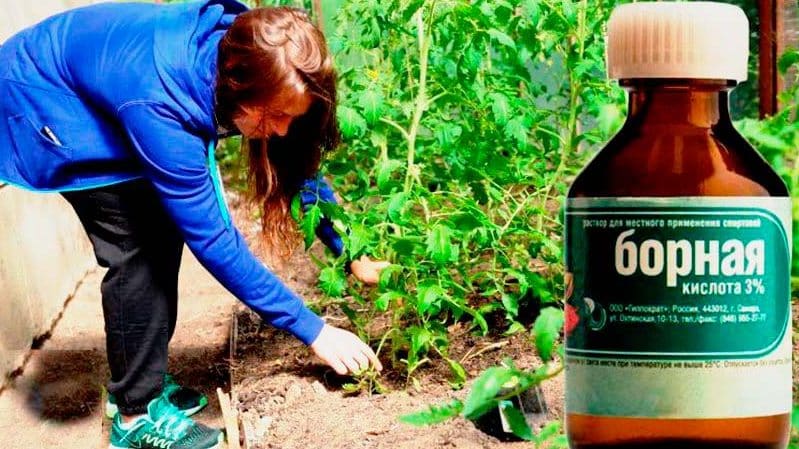
Precautionary measures
When preparing the solution, it is important to follow safety rules:
- do not carry out the procedure for preparing the solution and spraying without rubber gloves;
- spray the plants with a spray bottle;
- the plant may die from hypothermia, so make sure that the water temperature is not below 20-24°C;
- Do not spray plants in direct sunlight, as water can quickly burn the foliage of the plant;
- Do not spray plants during the flowering period.
Frequency and abundance of treatment
The first spraying is carried out at the moment of bud formation. The second spraying is carried out in the phase of maximum flowering of plants. It is important that during this period spraying is not abundant. The third spraying is carried out at the moment of mass fruiting.
If the concentration of boric acid is too high (more than 10 mg per 1 l), then the solution can harm the plant.This is due to the fact that the absorption of boron by plants is not controlled.
Advice from summer residents with experience
Experienced gardeners use boric acid for various purposes and give recommendations:
- Boric acid is added during the growth period of vegetables, because boron is not transferred to new shoots.
- If the soil is marshy, with a high carbonate content, fertilizing with boric acid is mandatory.
- For use in the garden, it is better to buy boric acid at a pharmacy or a special store for gardeners. Commercial boric acid for etching cockroaches or cleaning glass is not sufficiently purified. It contains substances harmful to the plant.
Boric acid is added to the garden throughout the entire vegetative process, since it is not transferred from grown stems to young ones and constantly requires renewal. Plants in marshy soils with a high carbonate content especially need boron. The element is necessary in soil with high acidity after it has been deoxidized by lime or other alkali-containing substances.
Conclusion
Use acid in the right amount - excess can damage the plant. With the correct use of boric acid solution, the yield can be increased several times. Boron is ideal for spraying and feeding roots. It is important not to neglect safety rules when preparing the solution and spraying.
Can you be trusted?
Quotes from the text:
“Do not spray plants during the flowering period.
…
The second spraying is carried out in the phase of maximum flowering of plants.”